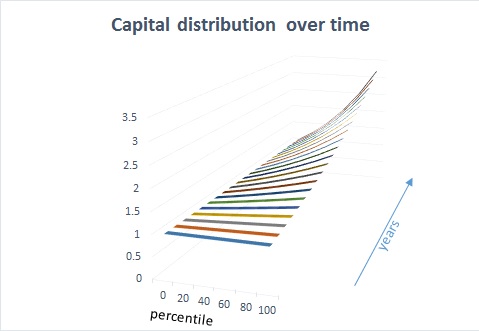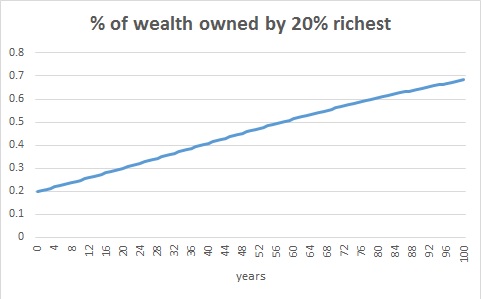I sometimes like thinking of an economy as an island: it is a simple model and usable to do thought experiments.
Suppose there was an island where most people are farmers and they all own the same size land. The economy works by people exchanging their products for others they need. The islanders use money as an intermediary for practical reasons. In a given year, a coconut farmer farms too many coconuts for himself and exchanges what he does not need for bread and other things. Or money. To buy something else later. You get the idea.
The coconut farmer does good business and manages to save up some money at the end of the year. Careful as he is, he invests his savings. He does this by buying a piece of land of a neigboughring farm (his neigbour goes on a wild party with the money) . The prudent farmer now collects rent on his newly acquired land.
Using the rent, he is able to buy more farmland the next year. Thus he manages to increase his wealth year by year. In the beginning this will be slow. But, as the size of the land he owns growth exponentially, the pace will increase.
There is no reason his wealth should ever really decrease: anything he gets from rent (he does not need the money to live, as he lives of his coconut farm income) he reinvests. Every year his farmland will grow. Every year, it will grow faster.
Some investors are smarter than others
If everybody on the island behaved in the same manner, effectively no land would be exchanged and there would be no change. But in real life, everybody doesn’t.
Investment returns differ per person. Some of this may be luck, some of this may be because some people structurally invest better than others. I am sure that there are some people that have lousy investment returns – structurally: people without any interest in investing, for example.
If this is the case stucturally (and it is), we can calculate a distribution of wealth after making a few basic assumptions.
For ease of calculation, I will divide the people of the island into ten percentiles. The first percentile are the ones who have no investment returns. The last percentile have 6% investment returns (this is an assumption). The percentiles in between are linearly distributed (another one).
The investment returns would be given by a simple formula: yield = 0.06 * x (with x between 0 and 1 representing the percentiles)
Obviously, the highest percentile would make more money than the lower ones. The wealth of the higher percentiles will increase exponentially (by 6% a year).

From the graph above, it is easy to spot that wealth would concentrate over time. In fact, if you look at the percentage of ALL wealth in the economy as owned by the highest two percentiles over time, you would get something like this:

At the rate given (6% difference between the best and worst investors), it would take about 100 years for 70% of the economy to be owned by 20% of the population.
This is mathematics and should happen in any country with a more or less free investment climate.
Some economic consequences
So, the coconut farmer does not change his lifestyle very much. The money he earns, he reinvests. The rest of the Island inhabitants have to pay more and more interest to him and so presumably can consume less.
As the coconut farmer owns more and more of the island, land available for sale will become harder to come by. The price of land will increase. This will increase the paper-fortune of the coconut farmer. As the rents as a percentage of landprices decrease, interest rates will decline.
The demand for money would increase (the ‘investment’ component of the economy grows) and the monetary authorities could oblige. If they did, the extra money in circulation would be mostly used by farmers buying and selling land and for rent payments.
A very simple model.